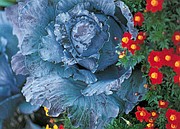Super companion planting list includes veggies, herbs, flowers
Though June 5 is still the optimum – safest – time to plant the veggies (and most everything else) it’s a good idea to spend some of March’s bluster planning where and how to work with some of your favorites. Over the years, this column has enlarged its focus to include companions of every ilk – veggies, fruits, herbs, flowers and even some “weeds” – for you to utilize or ignore as you see fit. That said, here’s your annual list. Enjoy!
Remember, some companion plants can serve as “trap crops” that will draw the foliage/bulb eaters and their larva away from the main crop. The following chart offers choices for protection and beauty to your personal garden landscape. I’ve termed plants as “Friends” – which grow well together, or “Foes” – that deter proper beneficial interaction. You’ll note that some veggies are pretty tolerant while a few others are averse to certain bed-partners.
•••
Asparagus: Friends — tomatoes, parsley, basil;
Green and/or wax beans: Friends — corn, potatoes, carrots, cucumbers, cauliflower, cabbage, petunias, oregano, mustard, summer savory, rosemary; Foes: onions, garlic, gladiolus.
Pole beans: Friends — corn, squash, oregano, mustard, summer savory; Foes: onions, beets, sunflowers, cole crops.
Beets: Friends: onions and Coles; foes: pole beans.
Coles: (broccoli, Brussels sprouts, cabbage, cauliflower, kale, kohlrabi): Friends: mint, dill (and most aromatic herbs), potatoes, celery, beets, onions (cabbage particularly likes sage); Foes: strawberries, tomatoes, pole beans.
Chinese cabbage (different from the American cole crops) — Friend to peas, but Enemy of pole beans.
Carrots: Friends — peas, lettuce, chives, tomatoes, onions, rosemary, sage; Foe — dill.
Corn: Friends — potatoes, cucumbers, peas, beans, squash.
Cucumbers: Friends — beans, corn, peas, radishes, sunflowers; Foes — aromatic* herbs, potatoes.
Eggplant: Friends – beans, basil.
Fennel: While a delicious bulb with licorice-flavored fronds (that flavor baked fish), fennel is not a Friend to most anything in the garden. Give it a private space with sunlight and rich soil away from the veggie garden;
Leeks: Friends — celery, carrots and onions.
Lettuce: Friends — carrots, radishes, strawberries, cucumbers.
Melons: Friends — beans, corn, peas, radishes, thyme, sunflowers; Foes – potatoes, most aromatic herbs.
Onions: Friends — beets, strawberries, tomatoes, lettuce, chamomile, summer savory; Foes: peas, beans.
Parsley: Friends – (and beneficial to), tomatoes, asparagus, roses. (Parsley serves double duty as food for the swallowtail butterfly’s larvae (a striped green/black caterpillar). I once suggested planting “sacrifice” parsley as a beneficial ornament in the rose garden, and planting the kitchen parsley in the veggie garden.
Peas: Friends — most vegetables and herbs; Foes — onions, garlic, gladiolus, potatoes.
Peppers (Sweet bells/Hot): Friends — most vegetables and herbs; Foes: onions, garlic, gladiolus, potatoes .
Potatoes: Friends — beans, corn, cabbage, horseradish, eggplant, gladiolus; Foes — pumpkins, squash, cucumbers, sunflowers, tomatoes, raspberries.
Pumpkins, gourds: (See squash).
Radishes: Friends — peas, nasturtiums, lettuce, chervil, cucumbers (planting lots of radishes with your peas and cukes will trap many harmful pests).
Roses: Friends — Borage, chives, garlic, lavender, leeks, mint, parsley, rosemary, rue, sage, santolina, thyme, wormwood (Artemisia), Tansy.
Rutabaga, turnips: Friend to peas, but NOT each other: Remember that these related crops (including radishes) will cross with each other, also with Chinese cabbage and Oriental mustard, so don't plant together if you want true-to-species produce.
Squash (summer and winter): Friends – nasturtiums, corn. (Plant only one variety of squash per species to prevent crosses).
Spinach and chard: Friends to strawberries — plant in the strawberry bed for mutual benefit.
Tomatoes: Friends — chives, borage, thyme, onions, parsley, asparagus, marigolds, carrots, nasturtiums; Foes: Cole crops, potatoes, fennel.
Watercress/mustards: Compatible with most vegetables and aromatic herbs.
•••
*Note: Several references to "aromatics" can include nasturtiums, calendula and marigolds as well as the following: Sage, tarragon, chives, sweet marjoram, summer savory, dill, rosemary, basil, mints (which include Betony), oregano, thyme, sorrel, all culinary herbs. Perennial culinary sage can provide a pretty focal point among your cole plants.
Non-culinary herbs like rue, the artemisias (wormwood, mugwort, etc.), are NOT good in the vegetable garden, but truly valuable in other areas of the landscape. A tea made of rue or wormwood sprayed on plants plagued by aphids, etc., with deter and/or kill them.
Umbellifers (think umbrella-tops) make great trap crop plants for attracting “Good Guys”: Caraway, dill, and Sweet Annie attract syrphid flies which prey on many species of aphids. The tiny beneficial wasps that parasitize the eggs of caterpillars, loopers and other destructive worms, also relish a variety of umbellifers including Yarrow, Tansy, Valerian and Angelica. White cosmos attracts the valuable lacewing, which eats aphids, thrips and mealybugs. These and many other valuable insects are assets to the gardens, which gives you good reason never to spray. Companion gardens are designed to be care-free.
Special caveats: Pay special heed to the Foes and never plant them with their listed enemies. Some reactions are destructive to the non-friendly plants. Plant catnip/catmint around borders as flea beetle control; Yarrow is beneficial interplanted with all veggies and compatible with most aromatic herbs.
Tansy deserves special mention here: Though considered a noxious plant — dangerous to grazing cattle — small clumps here and there in the landscape are beneficial as a trap crop, particularly with roses, peonies, raspberries, grapes, and fruit trees. Those that I keep as companion to my many Peonies are always literally covered with tiny pollinators with never a “bad guy” on any of the surrounding flowering plants.
Companion planting, inter-planting and trap-crop gardening are both practical and beautiful, so use the preceding information to plan and plant your vegetable/herb/ornamental gardens for healthy, successful harvests.
Valle Novak writes the Country Chef and Weekend Gardener columns for the Daily Bee. She can be reached at bcdailybee@bonnercountydailybee.com or by phone at 208-265-4688 for questions between the hours of 8 a.m. to 6:30 p.m. a 208-265-4688.





